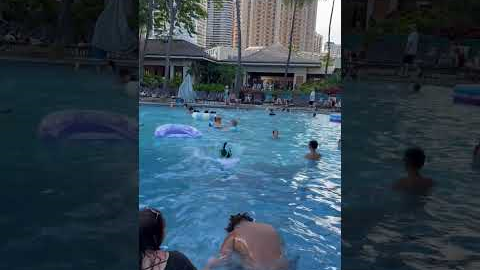Hilton Hawaiian Village Waikiki Beach Resort Super Pool
21,837 View
Share this Video
- Publish Date:
- July 27, 2025
- Category:
- Tourism
- Video License
- Standard License
- Imported From:
- Youtube
Tags

The Super Pool at Hilton Hawaiian Village Waikiki Beach Resort is a vibrant oasis of aquatic delight that epitomizes the essence of relaxation and fun in the heart of Waikiki, O'ahu. Spanning across a sprawling area, the Super Pool offers an unforgettable aquatic experience that caters to visitors of all ages, making it the perfect focal point for a memorable resort stay.
Upon arriving at the Super Pool, the sheer size and expanse of the water complex immediately captivate. The main pool, surrounded by lush tropical foliage, shimmers invitingly under the Hawaiian sun. Its crystal-clear waters beckon guests to take a refreshing dip, cool off from the warm island weather, or simply lounge by the poolside, basking in the idyllic surroundings.
The pool area is a haven for both relaxation and recreation. Comfortable lounge chairs and shaded cabanas dot the poolside, providing cozy spots to unwind while enjoying the captivating views of the Pacific Ocean in the distance. As the sun dances across the water's surface, it's easy to lose track of time while indulging in leisurely moments of tranquility.
For those seeking a bit more excitement, the Super Pool delivers with an array of water activities. Waterslides wind their way through the tropical landscape, offering exhilarating twists and turns that delight guests of all ages. Families and friends can race down these water chutes, sharing laughter and creating cherished memories along the way.
The Super Pool is not just a pool; it's a hub of aquatic experiences. The lively atmosphere is complemented by a poolside bar where tropical drinks and refreshments are served, ensuring that the relaxation continues without interruption. Children are treated to a dedicated keiki (kids) pool area, complete with water features and splash zones, ensuring that every member of the family can enjoy their time to the fullest.
As the day transitions into evening, the Super Pool takes on a magical quality. The ambient lighting transforms the area into a serene retreat, where guests can enjoy a leisurely swim under the starlit Hawaiian sky or simply unwind with a drink in hand.
The Super Pool at Hilton Hawaiian Village Waikiki Beach Resort is more than just a pool—it's a vibrant center of leisure, adventure, and rejuvenation. It embodies the spirit of Hawaii, offering a place where guests can create lasting memories while immersing themselves in the beauty and vitality of the island paradise. Whether seeking relaxation, fun, or a little bit of both, the Super Pool is a must-visit destination for anyone looking to experience the best of Waikiki's aquatic allure.
Securing Our Oceans: Marine Conservation for Sustainable Biodiversity and Ecosystem Resilience
The health of our oceans is paramount to the well-being of our planet. Marine conservation plays a crucial role in maintaining sustainability, preserving biodiversity, protecting ecosystems, and ensuring long-term resilience. As we navigate the challenges facing our marine environments, a comprehensive approach to conservation is essential for safeguarding these invaluable resources for future generations.
## Understanding Marine Conservation
Marine conservation involves the protection and management of ocean ecosystems to prevent species extinction, preserve genetic diversity, and maintain ecological processes. It encompasses a variety of strategies aimed at mitigating human impact on marine environments, ensuring that our oceans remain vibrant and productive.
### The Importance of Biodiversity
Biodiversity in marine ecosystems is fundamental to their stability and functionality. Diverse species contribute to ecosystem services such as nutrient cycling, carbon sequestration, and the provision of food resources. A rich variety of organisms ensures that ecosystems can withstand and recover from disturbances, whether they are natural events or anthropogenic pressures.
### Sustaining Ecosystem Health
Healthy ecosystems are the backbone of marine conservation. They provide habitat for marine life, support fisheries, and protect coastal areas from erosion and extreme weather. Maintaining the integrity of these systems requires a delicate balance of preserving natural habitats and managing human activities that may disrupt ecological processes.
## Strategies for Marine Protection
Effective marine protection hinges on the implementation of robust conservation strategies. These strategies must address both the immediate threats to marine environments and the long-term sustainability of ocean resources.
### Establishing Marine Protected Areas
Marine Protected Areas (MPAs) are designated regions where human activities are regulated to conserve marine life and habitats. MPAs can range from no-take zones, where all extractive activities are prohibited, to areas with limited restrictions. By limiting human impact, MPAs help preserve critical habitats, allowing ecosystems to function naturally and species populations to recover.
### Combating Overfishing
Overfishing poses a significant threat to marine biodiversity and ecosystem health. Implementing sustainable fishing practices is essential to prevent the depletion of fish stocks and the disruption of marine food webs. Measures such as setting catch limits, enforcing fishing regulations, and promoting responsible seafood consumption are vital components of effective marine conservation.
### Reducing Pollution
Marine pollution, including plastic debris, chemical contaminants, and nutrient runoff, degrades water quality and harms marine life. Efforts to reduce pollution involve improving waste management practices, regulating industrial discharges, and promoting the use of environmentally friendly products. Cleaner oceans support healthier ecosystems and more resilient marine species.
## Restoration Efforts for Marine Ecosystems
In addition to protection, restoration initiatives are critical for repairing damaged marine environments and enhancing their resilience. Restoration projects can help recover ecosystems that have been degraded by human activities or natural events, ensuring that they continue to provide essential services.
### Coral Reef Restoration
Coral reefs are among the most diverse and productive marine ecosystems, yet they are highly vulnerable to climate change, pollution, and physical destruction. Coral restoration efforts involve cultivating coral fragments in nurseries and transplanting them onto degraded reefs. These initiatives help rebuild coral populations, supporting the myriad of species that depend on reefs for habitat and sustenance.
### Mangrove Restoration
Mangroves serve as crucial buffers between land and sea, protecting coastlines from erosion, providing nursery grounds for fish, and sequestering carbon. Restoration projects focus on replanting mangrove trees, rehabilitating damaged areas, and preventing further destruction through sustainable land-use practices. Healthy mangrove forests contribute to the overall resilience of coastal ecosystems.
### Seagrass Meadows Rehabilitation
Seagrass meadows are vital for maintaining water quality, supporting marine life, and storing carbon. Rehabilitation efforts include planting seagrass in areas where it has been lost, improving water clarity through sediment management, and reducing nutrient pollution. Restored seagrass beds enhance the health and resilience of marine ecosystems.
## Building Resilience in Marine Ecosystems
Resilience refers to the ability of ecosystems to absorb disturbances and recover from stresses. Strengthening the resilience of marine environments involves enhancing their capacity to withstand and adapt to changing conditions, whether driven by climate change or other factors.
### Climate Change Mitigation
Climate change poses a significant threat to marine ecosystems through rising temperatures, ocean acidification, and sea-level rise. Mitigation efforts include reducing greenhouse gas emissions, protecting carbon-rich habitats like mangroves and seagrasses, and promoting renewable energy sources. Addressing climate change is essential for maintaining the long-term health and resilience of our oceans.
### Enhancing Genetic Diversity
Genetic diversity within marine species contributes to their ability to adapt to environmental changes and resist diseases. Conservation strategies that protect a wide range of genetic variants enhance the overall resilience of populations. This includes preserving diverse habitats and preventing overharvesting of specific species.
### Promoting Sustainable Practices
Sustainable management of marine resources ensures that human activities do not compromise the health of ecosystems. Practices such as sustainable fishing, responsible tourism, and the use of eco-friendly technologies support the long-term viability of marine environments. Encouraging communities to adopt sustainable behaviors fosters a culture of stewardship and conservation.
## The Role of Education and Advocacy
Education and advocacy are pivotal in advancing marine conservation efforts. Raising awareness about the importance of oceans and the threats they face inspires individuals and communities to take action. Educational programs, public campaigns, and community engagement initiatives empower people to contribute to the protection and restoration of marine ecosystems.
### Engaging Local Communities
Local communities are often the stewards of marine environments. Involving them in conservation planning and decision-making ensures that strategies are culturally appropriate and effectively address local needs. Community-based initiatives, such as volunteer clean-up events and sustainable resource management projects, foster a sense of ownership and responsibility for marine conservation.
### Promoting Policy Change
Effective marine conservation requires supportive policies and frameworks at local, national, and international levels. Advocating for stronger environmental regulations, increased funding for conservation programs, and the enforcement of existing laws are essential for creating an enabling environment for marine protection and restoration.
### Encouraging Research and Innovation
Ongoing research and innovation are critical for developing new approaches to marine conservation. Scientific studies provide valuable insights into ecosystem dynamics, species interactions, and the impacts of human activities. Investing in research and fostering innovation drives the advancement of effective conservation techniques and technologies.
## The Future of Marine Conservation
The future of marine conservation depends on our collective commitment to protecting and sustaining our oceans. By prioritizing sustainability, preserving biodiversity, maintaining healthy ecosystems, ensuring protection, facilitating restoration, and building resilience, we can secure the health of our marine environments for generations to come.
As we advance, it is imperative to integrate conservation efforts with social and economic considerations, ensuring that marine protection benefits both the environment and the communities that rely on it. Collaborative efforts among governments, organizations, scientists, and individuals will drive the success of marine conservation initiatives, fostering a harmonious relationship between humanity and the ocean.
Together, we hold the responsibility and the power to safeguard our oceans, ensuring that they continue to thrive and support life on Earth. Through dedicated marine conservation, we can achieve a sustainable and resilient future for our planet’s most vital ecosystems.
https://www.youtube.com/embed/G-Do1ERJpFw














